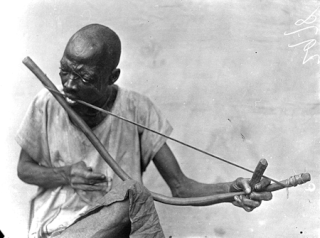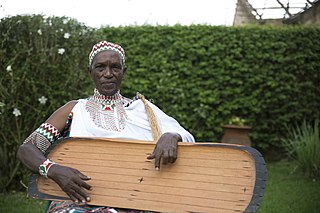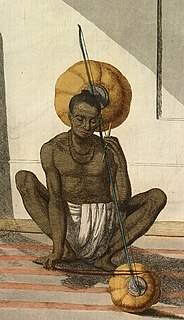
String instruments, stringed instruments, or chordophones are musical instruments that produce sound from vibrating strings when a performer plays or sounds the strings in some manner.
Hornbostel–Sachs or Sachs–Hornbostel is a system of musical instrument classification devised by Erich Moritz von Hornbostel and Curt Sachs, and first published in the Zeitschrift für Ethnologie in 1914. An English translation was published in the Galpin Society Journal in 1961. It is the most widely used system for classifying musical instruments by ethnomusicologists and organologists. The system was updated in 2011 as part of the work of the Musical Instrument Museums Online (MIMO) Project.

The musical bow is a simple string instrument used by a number of South African peoples, which is also found in the Americas via slave trade. It consists of a flexible, usually wooden, stick 1.5 to 10 feet long, and strung end to end with a taut cord, usually metal. It can be played with the hands or a wooden stick or branch. It is uncertain if the musical bow developed from the hunting bow, though the San or Bushmen people of the Kalahari Desert do convert their hunting bows to musical use.

Traditional Tswana music is performed by Tswana people during feasts and special occasions such as beer gatherings, weddings and initiation ceremonies. Some of the instruments used include the segaba and setinkane. The segaba is more like a violin, in the design, but uses only one string hooked to a tin. The setinkane is made with varying forks, and played more like a keyboard.

The tro is Cambodia's traditional spike fiddles, bowed string instruments that are held and played vertically. Spike fiddles have a handle that passes through the resonator, often forming a spike, on the bottom side where it emerges. The family is similar or distantly related to the Chinese erhu or huqin. The instruments have a soundbox at the bottom of the stick, covered with leather or snake skin. Strings run from pegs at the top of the stick and secured at the bottom, running across the soundbox. The larger the soundbox, the lower the pitch range. Instruments in this family include the two-stringed tro ou, tro sau thom, tro sau toch and tro che, as well as the three-stringed tro Khmer spike fiddle. The two-stringed tros are tuned in a fifth, while the three-stringed tro Khmer is tuned in fourths. The tros, with the exception of the tro Khmer, are strung so that the bowstring is permanently placed between the two stings. When the musician plays, the placement of the bow causes the strings to be played at once, one from below and one from above. In contrast, western fiddles are played with the bow pushing on each string from the outside, as is also the case with the tro khmer.

The bladder fiddle was a folk instrument used throughout Europe and in the Americas. The instrument was originally a simple large stringed fiddle made with a long stick, one or more thick gut strings, and a pig's-bladder resonator. It was bowed with either a notched stick or a horsehair bow.
Traditional Thai musical instruments are the musical instruments used in the traditional and classical music of Thailand. They comprise a wide range of wind, string, and percussion instruments played by both the Thai majority as well as the nation's ethnic minorities.

Angular harp is a category of musical instruments in the Hornbostel-Sachs system of musical instrument classification. It describes a harp in which "the neck makes a sharp angle with the resonator," the two arms forming an "open" harp. The harp stands in contrast to the arched harp or bow harp in which the angle is much less sharp and in which the neck curves away from the resonator. It also stands in contrast to the frame harp which is a "closed harp" and in which there is no opening between the resonator and the upper tip of the harp, but has a third side forming a triangle.

The yazh is an harp used in ancient Tamil music. It was strung with gut strings that ran from an curved ebony neck to a boat or trough-shaped resonator, the opening of which was a covered with skin for a soundboard. At the resonator the strings were attached to a string-bar or tuning bar with holes for strings that laid beneath of the soundboard and protruded through. The neck may also have been covered in hide.

Bar zither is class of musical instruments within the Hornbostel-Sachs classification system for a type of simple chordophone, in which the body of the instrument is shaped like a bar.

The tube zither is a stringed musical instrument in which a tube functions both as an instrument's neck and its soundbox. As the neck, it holds strings taut and allows them to vibrate. As a soundbox or it modifies the sound and transfers it to the open air. The instruments are among the oldest of chordophones, being "a very early stage" in the development of chordophones, and predate some of the oldest chordophones, such as the Chinese Se, zithers built on a tube split in half. Most tube zithers are made of bamboo, played today in Madagascar, India, Southeast Asia and Taiwan. Tube zithers made from other materials have been found in Europe and the United States, made from materials such as cornstalks and cactus.

Trough zithers are a group of African stringed instruments or chordophones whose members resemble wooden bowls, pans, platters, or shallow gutters with strings stretched across the opening. A type of zither, the instruments may be quiet, depending upon the shape of the bowl or string-holder. Sound is often amplified with the addition of a gourd resonator. Instruments have been classed into five different types, based on shape.

The pināka vīnā was an Indian musical instrument, a musical bow that was itself played with a bow. It has also been transliterated pinaki vina and pinak.

Frame zither is a class of musical instrument within the Hornbostel-Sachs classification system for a type of simple chordophone, in which the body of the instrument is made from a frame.











